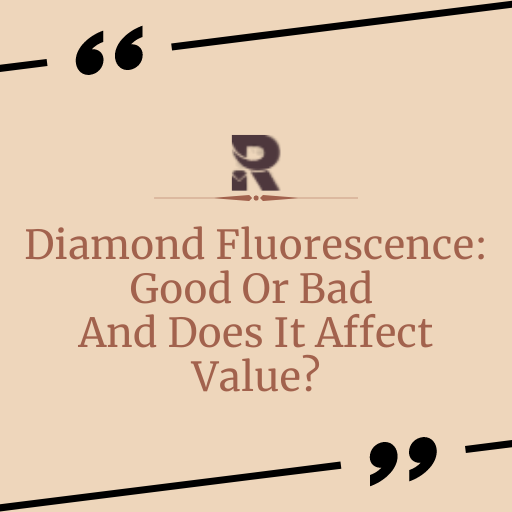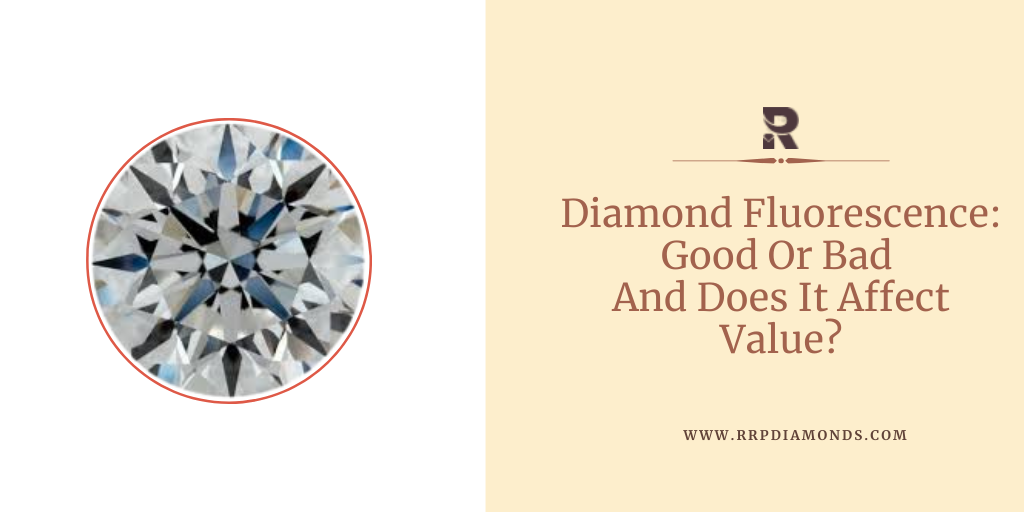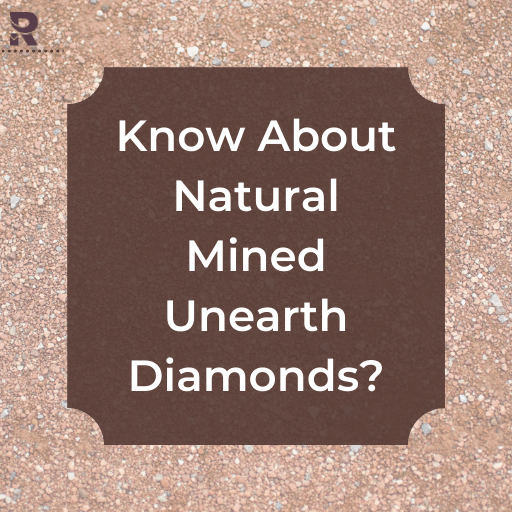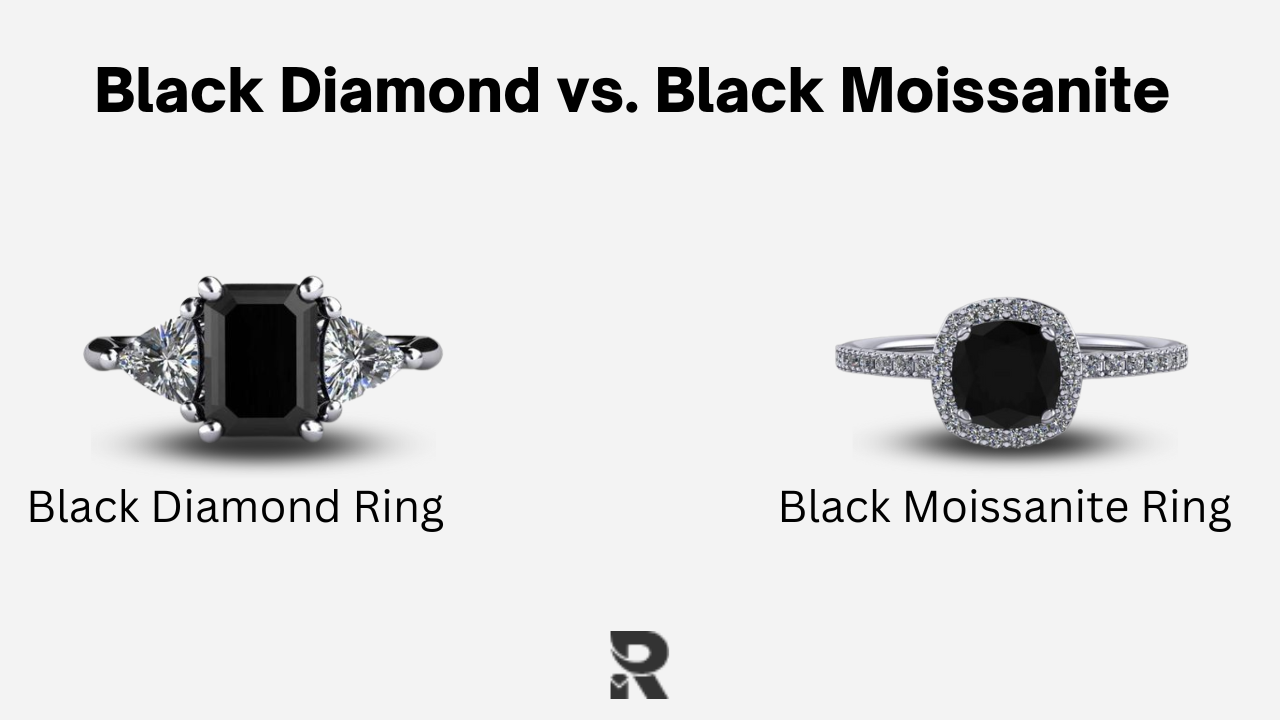
Diamond fluorescence is the glow that is visible to us when a diamond emits visible light after being exposed to ultraviolet rays (UV rays) or fluorescent lamps. The diamond exhibits a blue color under UV lights hence making this color appear to be a grade higher than its true color.

Approximately about 20%-30% of the diamonds out there show fluorescence to a certain degree. It is not exhibited by all of them. The fluorescence in different colors but a blue glow is most commonly visible as it is the complementary color to blue).
Very rarely do we see diamonds have a green, yellow, white, or even a red glow. Based on whichever diamond you select; its fluorescence can enhance or diminish the diamond’s color.
HOW MANY TYPEs OF DIAMOND FLUORESCENCE ARE THERE?
According to the Gemological Institute of America (GIA), the fluorescence of a diamond is not one of its grading factors hence, it does not fall under the category of the 4C’s (cut, clarity, color, weight) of the diamond. Rather it is more of an identifying characteristic graded according to its intensity. It has a separate grading system, which is as follows:
- None
- Faint
- Medium
- Strong
- Very strong.
STRONG OR VERY STRONG FLUORESCENCE:
Diamonds with such inflorescence generally appear to be a bit hazy or milky. The fluorescence under this grade would be visible by a gemological expert under highly controlled settings. The naked eye may find it very difficult to distinguish or even identify fluorescence.
MEDIUM FLUORESCENCE:
Medium fluorescence can also be identified by an expert. These diamonds also appear milky similar to diamonds with strong fluorescence.
FAINT FLUORESCENCE AND BELOW:
This type of fluorescence can hardly be visible by the naked eye. It can only be observed by trained GIA specialists under a controlled setting using special UV lights as the light source. Sometimes it is difficult for even the highly trained gemologist to distinguish between fluorescences between diamonds that are kept faced up side by side. These are more prominent in the Colorless grade diamond.
GIA’S STUDY ON FLUORESCENCE
According to a study done by the Gemological Institute of America (GIA), The different levels of fluorescence-based on varying intensities do not have a very perceptive effect on the color appearance of diamonds when observed upside down under appropriate lighting. Diamonds under the range I – K which is “near-colorless” or “faint yellow” have the most effect on the color appearance when the fluorescence is “strong” or “very strong”
EFFECT OF LIGHTING ON DIAMOND FLUORESCENCE
The right spectrum of Ultraviolet (UV) rays can affect the appearance of fluorescent diamonds. Upon discovering the how’s of the phenomenon gemologist moved on to set a standard for lighting for grading colors without a UV component.
This standard was updated in the year 2008. Today the color of diamonds is graded under a lightbulb which is equivalent to normal daylight and has a UV component. Consequently, the fluorescence effect is built in the color grades of diamonds.
The UV component of light needs to be approximately 30microwatts/cm2. This is considered as the optimum light as it is very similar to bright light on a summer sunny day and has an Ultra-violet index of 10.
Under such lighting conditions, if the majority of your time is spent indoors the diamond being at a short distance from a light bulb, may worsen the color grade of the diamonds in appearance.
Also read: Diamond Carat: Understand Sizing and Measurement Guide
Fluorescence does not improve your diamond’s color grade rather it only enhances or worsens the color grade under various settings of life.
CAN FLUORESCENCE MAKE A DIAMOND LOOK BRIGHTER?
The most common fluorescent glow seen in diamonds is blue. Since this is a color that complements the yellow color, Blue in fluorescence can make diamonds in the “light yellow” (I-J) grade appear brighter by one or two grades, depending upon the intensity of the inflorescence.
Hence, diamonds in the I-M which possess fluorescence from the “medium” to the “strong” range are slightly more expensive and come with a small premium compared to those diamonds which have “none” or “faint” fluorescence.
Do keep in mind that a diamond’s fluorescence does not in any way change the color grade of a particular stone, rather it only alters the diamond’s color appearance under laboratory settings or bright light settings.
For instance, under bright sunlight, a diamond with a “strong” blue fluorescence may cause a diamond with a yellow hue to appear more colorless but the same fluorescence can cause a “colorless” or a “near-colorless” diamond to appear as milky, oily, or hazy, thus reducing its brightness and consequently its beauty.
Hence, with the right color grade, diamond fluorescence can be beneficial or detrimental to the appearance of your diamond.
- Consider a diamond with a color grade of G or any higher color grade on the scales with a fluoresce of “Medium” blue, you will find that these diamonds under UV or natural sunshine would appear milky or hazy
- Whereas the diamonds with a higher color grade such as the colorless range (D, E, F) or the near-colorless range (H, I, J, K) do not benefit from any kind of fluoresce. On the contrary diamonds of these grades with fluorescence are considered as less valuable compared to when they do not have any fluorescence. Consequently, High color grade diamonds with fluorescence cost less since they are less in demand.
- Diamonds with a slight yellow hue such as those in the “Faint yellow” (K, L, M) or “Light yellow” (N-S) benefit from blue fluorescence as they look brighter under sunlight, and thus cost more per carat and come with a slight premium compared to when diamonds of this color grade lack fluorescence.
FLUORESCENCE AND HAZY DIAMONDS
Keeping the color grade of your diamond aside, the following is found true concerning fluorescence and haziness of a diamonds:
- Diamonds in the “strong” or “very strong” category almost every time appear hazy, regardless of the color grade.
- Diamonds with “Medium” fluorescence rarely appear hazy. Sometimes even enhances the appearance of low color grade diamonds.
- “Faint” or “none” fluorescence in diamonds will never appear oily or hazy regardless of the color grade.
The table below can provide for you a more concise relation between the price fluctuations in diamonds with respect to their fluorescence and clarity.
| COLOR GRADE | CLARITY | V. STRONG | STRONG | MEDIUM | FAINT |
| D-F | IF – VVS2 | -10 to -15% | -7 to -10% | -3 to -7% | -1% |
| VS1 – VS2 | -6 to -10% | -3 to -5% | -1 to -2% | 0% | |
| SI1 – I3 | 0 to -3% | 0 to -1% | 0% | 0% | |
| G-H | IF – VVS2 | -7 to -10% | -5 to -7% | -1 to -3% | -1% |
| VS1 – VS2 | -3 to -5% | -2 to -3% | 0 to -2% | 0% | |
| SI1 – I3 | 0% | 0% | 0% | 0% | |
| I-M | IF – I3 | 0 to +2% | 0 to +2% | 0 to +2% | 0% |
*IF – Internally flawless
*VVS2 – Very, Very slightly included.
*VS1 – VS2 – Very slightly included.
*SI – Slightly included
PRICE OF DIAMONDS ACCORDING TO FLUORESCENCE
A very clear price difference is seen in fluorescent diamonds. Fluorescent diamonds have a lower price compared to those with no inflorescence.
Below is a table price comparison of 1ct, excellent cut, VS2 diamonds according to the database of Blue Nile. It shows varying price figures across different intensities of fluorescent levels. You can compare these prices with a diamond of similar 4C characteristics, but without fluorescent.
| COLOR | NONE | FAINT | MEDIUM | STRONG |
| D | $8,878 | $8,087 | $7,364 | $6,977 |
| E | $8,258 | $7,569 | $7,041 | $6,782 |
| F | $7,848 | $6,749 | $6,749 | $6,533 |
| G | $7,291 | $6,731 | $6,731 | $6,236 |
| H | $6,897 | $6,415 | $6,415 | $6,078 |
| I | $6,012 | $6,062 | $6,062 | $5,412 |
| J | $5,399 | $4,775 | $4,775 | $4,718 |
- According to the table, you can see that diamonds with the color grade D having a “strong” fluorescence have a similar price to that of H color diamond with no fluorescent. It is important to note that a D grade “colorless” diamond is considered as the highest color grade possible whereas an H color grade falls in the “nearly colorless” grade.
- And a diamond with I color grade has about the same cost as a J color grade diamond with no fluorescence.
- Hence these prices are not continuous with the fluorescent grades.
CAN AN AVERAGE PERSON RECOGNIZE FLUORESCENCE?
Ever heard of the statement “beauty is in the eyes of the beholder”? you can pretty much apply the same logic to diamonds and fluoresce.
According to GIA experts “For an average observer, meant to represent the jewelry buying in public, no systematic effects of blue fluorescence on the face-up appearance of the groups of diamonds were detected. Even experienced observers did not consistently agree on the effects of fluorescence from one stone to the next.”
To put it more simply, it is nearly impossible for an average person to examine two diamonds and compare their fluorescence.
Hence, you can select your diamond based on what you perceive. Under sunshine or experimental UV lights, you can observe fluorescence.
But bear in mind that fluorescence only enhances the appearance of a diamond from the color grade K and below. It visibly makes no difference for a “colorless” or “near-colorless” grade of diamonds.
The only exceptions for them are when the fluoresce is of “strong” or “very strong” intensity. In such a situation it can downgrade the appearance of your high color grade diamond.
PURCHASING DIAMONDS ONLINE VS IN STORE
It will not come as much of a surprise that purchasing diamonds in person is ten folds better than buying them online. It also saves you money while ensuring that you get the highest quality for your price, especially if you are considering buying a “strong” blue, fluorescent light.
While buying it in-store by yourself, ensure that whichever diamond you choose with a “strong” blue fluorescence does not come with a haziness or milky appearance. The best way to evaluate a diamond’s fluorescence is in person under varying light sources such as UV light or sunlight or lamp lights. You can always ask your retailer to see these diamonds under these lights.
When it comes to online shopping for diamonds. Even with the photographs captured by the best photographers out there, you will not be able to distinguish between the fluorescence and compare it with different lightings.
Because when it comes to photography, the brightness, saturation, and pixels of the camera play a crucial role in the photograph, and more often than less it ends up interfering with the look of the actual diamond. Therefore, there is a massive probability that you may not get the quality of the product for which you would have paid.
But if you still prefer to purchase it online, our best recommendation for you would be to steer clear of any diamonds with a “strong” blue fluorescence. Or purchase it from a store that has a stellar return policy in case the diamond is not to your liking or if its appearance is hazy.
We at RRP offer the best quality diamonds and our online stores try their best to depict every factor of a diamond with the help of photos and videos. Every single diamond is certified by GIA and IGI. Our gallery of diamonds will be a treat once you view them.
SOME TIPS TO HELP YOU SELECT THE RIGHT FLUORESCENCE.
- Fluorescence can be good or bad depending upon the color grade of our diamond. It is bad for diamonds with a higher color grade and enhances the appearance of diamonds that have a yellow hue to them.
- You can select one according to your perception of the diamond. (make sure you observe the diamond in the right light setting i.e., bright or UV light)
- A “Faint” fluorescence in a diamond can save you some money, without missing out on the quality of the diamond.
- It is always best to go over the return policy of your retailer at least once before your purchase.
- Keep in mind that fluorescence is not a major factor. And the 4c’s (cut, carat, clarity, color) are your priority. For a high-quality diamond, the 4c’s have to complement each other.
Also read: The Beauty of Antique diamond
Conclusion Thoughts
We can conclude that the fluorescence of a diamond should not be considered as a major factor while selecting a diamond since the effects are nearly negligible to the naked eye. However, you can exercise the following precautions:
As diamonds in the high color grade such as “colorless” or “near-colorless” do not have enough body color to offset the intensity of fluorescence, resulting in a milky or hazy appearance, it is paramount that you:
- Be very cautious while purchasing a diamond with a “strong” fluorescence in high color grades (D, E, F)
- And while purchasing diamonds with a “very strong” fluorescence in the “Near colorless” (G, H) grade of diamonds.


